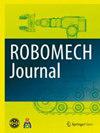非典型环境下一系列任务的快速原型设计:具有可靠的基于程序和灵活的基于学习方法的机器人系统
IF 1.7
Q3 INSTRUMENTS & INSTRUMENTATION
引用次数: 1
摘要
我们提出了一种新的机器人系统,它结合了可靠的基于编程的方法和高度可推广的基于学习的方法。如何在非典型环境中设计和执行一系列任务是一个具有挑战性的问题。如果所有任务都使用基于编程的方法来实现,那么开发成本将是巨大的。然而,如果使用基于学习的方法,可靠性是一个问题。在本文中,我们提出了新的设计指南,重点关注基于编程和基于学习的方法各自的优势,并对它们进行选择,使它们相互补充。我们对粗糙行为的运动使用基于程序的方法,对机器人和机器人任务对象之间需要复杂交互且难以用程序实现的动作使用基于学习的方法。我们的学习方法可以轻松快速地完成由各种运动组成的一系列任务,因为它不需要预先设计对象的计算模型。我们展示了一系列任务,其中使用实际机器人组装随机排列的零件。本文章由计算机程序翻译,如有差异,请以英文原文为准。
Rapid prototyping for series of tasks in atypical environment: robotic system with reliable program-based and flexible learning-based approaches
We propose a novel robotic system that combines both a reliable programming-based approach and a highly generalizable learning-based approach. How to design and implement a series of tasks in an atypical environment is a challenging issue. If all tasks are implemented using a programming-based approach, the development costs will be huge. However, if a learning-based approach is used, reliability is an issue. In this paper, we propose novel design guidelines that focus on the respective advantages of programming-based and learning-based approaches and select them so that they complement each other. We use a program-based approach for motions that is rough behavior and a learning-based approach for motion that is required complex interaction between robot and object of robot tasks and are difficult to achieve with a program. Our learning approach can easily and rapidly accomplish a series of tasks consisting of various motions because it does not require a computational model of an object to be designed in advance. We demonstrate a series of tasks in which randomly arranged parts are assembled using an actual robot.
求助全文
通过发布文献求助,成功后即可免费获取论文全文。
去求助
来源期刊

ROBOMECH Journal
Mathematics-Control and Optimization
CiteScore
3.20
自引率
7.10%
发文量
21
审稿时长
13 weeks
期刊介绍:
ROBOMECH Journal focuses on advanced technologies and practical applications in the field of Robotics and Mechatronics. This field is driven by the steadily growing research, development and consumer demand for robots and systems. Advanced robots have been working in medical and hazardous environments, such as space and the deep sea as well as in the manufacturing environment. The scope of the journal includes but is not limited to: 1. Modeling and design 2. System integration 3. Actuators and sensors 4. Intelligent control 5. Artificial intelligence 6. Machine learning 7. Robotics 8. Manufacturing 9. Motion control 10. Vibration and noise control 11. Micro/nano devices and optoelectronics systems 12. Automotive systems 13. Applications for extreme and/or hazardous environments 14. Other applications
 求助内容:
求助内容: 应助结果提醒方式:
应助结果提醒方式:


